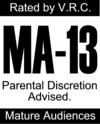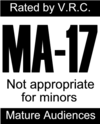Difference between revisions of "Videogame Rating Council"
From Sega Retro
Scarred Sun (talk | contribs) m (1 revision: Article imports from Sonic Retro) |
Scarred Sun (talk | contribs) |
||
| Line 65: | Line 65: | ||
Further complicating the situation was that games sold for the Sega home console systems were still being censored. Despite the MA-17 label, both ''Rise of the Dragon'' and ''Snatcher'' had some of the mature images edited. Even Sega of America did not seem to be taking its own rating system seriously as it radically altered ''Streets of Rage 3'' before it was sold outside of Japan, including the removal of a playable gay character. | Further complicating the situation was that games sold for the Sega home console systems were still being censored. Despite the MA-17 label, both ''Rise of the Dragon'' and ''Snatcher'' had some of the mature images edited. Even Sega of America did not seem to be taking its own rating system seriously as it radically altered ''Streets of Rage 3'' before it was sold outside of Japan, including the removal of a playable gay character. | ||
| − | [[Category:Game Rating Systems]] | + | [[Category:Game Content Rating Systems]] |
[[Category:Sega]] | [[Category:Sega]] | ||
Revision as of 15:49, 15 February 2010
The Videogame Rating Council (V.R.C.) was introduced by Sega of America in 1993 to rate all games that were released for sale in the United States of America on the Sega Genesis, Sega Game Gear, and Sega CD and rarely, some computer games. The rating had to clearly appear on the front of the box and on all the advertisements for the video game. The three different ratings were as follows:

|
General Audiences: Appropriate for all audiences. No blood or graphic violence. No profanity, no mature sexual themes and no usage of drugs or alcohol. Examples of games with this rating were: Disney's Aladdin, Ecco the Dolphin, Earthworm Jim, Sonic the Hedgehog 3 and most sports and puzzle games. |

|
MA-13 — Mature Audiences: Parental Discretion Advised. The game was suitable for audiences thirteen years of age or older. Game could have some blood in it and more graphic violence than a "GA" game. Examples of games with this rating were Bram Stoker's Dracula, Flashback: The Quest for Identity, Super Street Fighter II, Lunar: The Silver Star, Wing Commander and Beavis and Butt-head. |

|
MA-17 — Mature Audiences: Not appropriate for minors. The game was suitable for audiences seventeen years of age or older. Games could have lots of blood, graphic violence, mature sexual themes, profanity, drug or alcohol usage. Examples of games with this rating were: Leisure Suit Larry 6: Shape Up or Slip Out!, Lethal Enforcers, Mortal Kombat II, Rise of the Dragon and the Sega CD version of Mortal Kombat. |
- NYR or, Not Yet Rated: This rating only appeared in advertising and indicated that the game had not yet been rated by the V.R.C.
The rating symbols were not always in black and white; they were usually printed in colors matching the color scheme of the box.
Contents
Before the Videogame Rating Council
Before 1993, Sega was known for a more liberal policy with regards to what type of content it would allow in a video game release on a Sega home console. Where as Nintendo became famous for its strict censorship polices, Sega allowed blood and graphic violence in video games provided that such games had a generic parental advisory label on it.
The first company to take advantage of Sega's moral liberal polices was the company Razor Soft. In 1990 they released the 1988 computer game Techno Cop for the Sega Genesis. In the game you played a cop waging a one-man war against crime. Bits of what was intended to be red blood would come out when you shot criminals and civilians (some of which were children). The game had limited commercial success, but Razor Soft would continue to use mature themes in video games.
In 1991 they released a second computer game called Stormlord for the Sega Genesis. In the game you played a knight out on a quest to rescue female fairies who were imprisoned by an evil queen. In the computer version the fairies were nude, but Sega forced Razor Soft to give the fairies clothing when the game was released for the Sega Genesis. Like the game Techno Cop, Stormlord had limited commercial success and the implied nudity was panned as a cheap gimmick to cover up mediocre games.
That same year Tengen released the popular arcade game Pit Fighter for the Sega Genesis. The fighting game's characters were created by digital filming. The characters looked realistic and the game was a preview of what Midway Games would perfect with its Mortal Kombat arcade game. Pit Fighter had limited success because while its fighting looked more realistic than anyone had ever seen before on the Genesis, the animation was choppy and control did not provide the player with many fighting moves. Razor Soft would try and create a popular fighting game when it released Activision's Mondu's Fight Palace for the Sega Genesis, under the title of Slaughter Sport, which created characters through the traditional means of animation, however the game's alien characters had a certain subtle mature allure. One of the characters was a female punk that would attack with her mohawk hair.
In 1992 Namco released Splatterhouse 2 for the Sega Genesis. In the game you played a male character who wore a cursed mask, and had to fight the forces of evil to save your girlfriend. The blood in the game was green ooze that came out of the monsters that you killed. As with the case of the two Razor Soft games, Splatterhouse 2 had a parental advisory label on the game's box in tiny, red print. Splatterhouse 2 was a commercial success and led to the release of Splatterhouse 3 in 1993.
These games represented a small trickle of pre-V.R.C. games for the Sega Genesis. Most games were suitable for all audiences and most of these more mature games had limited commercial success because the blood or partial nudity was treated as a gimmick. Yet, two Sega Genesis games in 1992 created a national debate over the content of video and compelled Sega to develop the Videogame Rating Council.
Mortal Kombat
Previous attempts had been made at making an arcade fighting game that had realistic graphic violence and gore. Yet, Mortal Kombat was the first arcade game to combine realistic digitally created characters with the graphic violence and gore without making the objective mistakes that video & computer game reviewers would point out. The game had a wide range of fighting moves and combination of fighting moves that the player could learn. The arcade game had great graphics and animation and sound. Thus the controversial content could not be seen as a simple gimmick to cover up a mediocre game.
The video game company Acclaim brought the popular and ultra-violent video game to the Sega Genesis and Super Nintendo in 1992. Both Sega and Nintendo ordered the game's graphic violence and blood to be toned down.
However, Sega allowed the player to restore the controversial content with a secret code, announced the creation of the Videogame Rating Council and gave Mortal Kombat a MA-13 rating because you need the secret code to get the controversial content. The result was that the Sega Genesis version of Mortal Kombat outsold the sanitized Super Nintendo version. However, the commercial success of the game, including a huge marketing campaign by Acclaim to prepare consumers for "Mortal Monday", and the fact that the Videogame Rating Council opened the doorway for games to be sold on a Sega console system with adult content promoted national outrage.
Mortal Kombat was not the only game to prompt Sega to create the video game rating.
Lethal Enforcers
In 1993 Konami released the popular arcade game Lethal Enforcers for the Sega Genesis and Sega CD. In the first person game you shot at digitally created images of criminals. The game worked with an optional, blue toy gun called the Konami Justifier that you could buy and shoot at the game's criminals with, as opposed to simply using the regular controller. Lethal Enforcers was part of a series of first person shooting games that came out for the Sega Genesis and Sega CD in the early 1990's.
The major difference in each game was the setting and the introduction of games on a compact disc (CD). A CD could store much more memory then a cartridge and thus replaced the digitally created characters with streaming, full motion video. In 1993 American Laser Games brought Mad Dog McCree to the Sega systems set in the world of the Old West. In 1994 Who Shot Johnny Rock? changed the setting to the era of 1920's American gangsters, while Drug Wars was set in the contemporary environment of the US Drug Enforcement Agency]]'s War on Drugs.
Digital Pictures entered into the first person shooting genre with zombies Corpse Killer in 1994 and space aliens in Ground Zero: Texas. Sega even got into the genre with enemy aircraft in Tom Cat Alley. These full motion video Sega CD games had cheesy actors, low budget special effects and the Sega CD video capabilities were nowhere near film quality. Often the full motion video was not full screen and it looked grainy and pixelated due to the hardware limitations of the Sega CD. Yet, the graphics were realistic enough to ensure that the games automatically got a MA-13 or a MA-17 rating.
Night Trap
Games such as Lethal Enforcers restricted game play to shooting digitally created criminals, zombies and aliens. In 1992 Digital Pictures released a second type of full-motion video game based on voyeurism.
The premise of Night Trap was borrowed from slasher films. Sometime in the 1980's, a group of attractive college co-eds drive up to a lakehouse for a weekend slumber party only to find out that their friendly hosts -- the Martin family -- are Yuppie Vampires and that house is invaded by the "Augers." Your mission is to watch the events going on in the rooms, the low budget special effects and vampire violence to trap the Augers, save the college girls and their kid brother. The game has a timer running and you must figure out when you have to switch the cameras to trap an Auger, save one of your special forces soldiers -- including Kelli (Dana Plato) -- or listen to when the Martin family decided to change the security code. Once you memorized what camera you needed to view at what time, the game became a simple mad rush to switch between cameras leaving little time to watch the story unfold. Needless to say Night Trap has not aged well as full motion video games quickly became an "interactive" fad that died quickly.
Yet, in 1992 Night Trap's extensive full motion video was groundbreaking and while the game's content was within the boundary of a PG-13 rating, the fact that it had scenes with red liquid in jars and another scene with a female in a nightgown being attacked hinted at what full motion video could do in the future. Sega gave Night Trap a MA-17 label and the video game industry soon forgot about full motion video games because consumers grew weary of playing games that were either a format of a first person perspective shooting game or a format of switching between cameras in a house or hotel.
Night Trap is remembered by many because it was the game most often cited by media watchdog interest groups and members of the U.S. Congress that the video game industry was allowing games with graphic sex and violence in them.
Entertainment Software Rating Board
Sega phased out the Videogame Rating Council in late 1994 when the entire American video game industry agreed to follow the independent Entertainment Software Rating Board. The old Sega ratings can still be found on video games and advertisements that appeared from 1993 - 1994.
Criticism
Many video game reviewers and consumers saw the introduction of the Videogame Rating Council as a sign that Sega of America was no longer going to censor the content of video games sold for a Sega home console. While Sega had tolerated blood and graphic violence in video games pre-V.R.C., nudity, profanity, and homosexuality had remained prohibited themes and were often themes removed before an original computer game or a role-playing game was released for the English speaking Sega market.
In addition, Sega of America never released brochures to the public or explained the qualifications for a game getting a particular rating and thus there seemed to be inconsistencies. For example, the Sega CD editions of two computer games; Rise of the Dragon and Snatcher both got the MA-17 label and it was assumed that it was because of the violence, profanity, and sexual innuendos that existed, but Sega never explained. Another example, would be the fact that the Sega Genesis version of Mortal Kombat was given a MA-13 label, while the Sega CD version of the game was given a MA-17 label, with the only major content difference between the two games was that you needed to enter in a secret code in order for all the blood and graphic violence to be seen in the Sega Genesis edition. In the Sega CD edition the player had to enter in a secret code which would actually tone down the blood and graphic violence.
Further complicating the situation was that games sold for the Sega home console systems were still being censored. Despite the MA-17 label, both Rise of the Dragon and Snatcher had some of the mature images edited. Even Sega of America did not seem to be taking its own rating system seriously as it radically altered Streets of Rage 3 before it was sold outside of Japan, including the removal of a playable gay character.